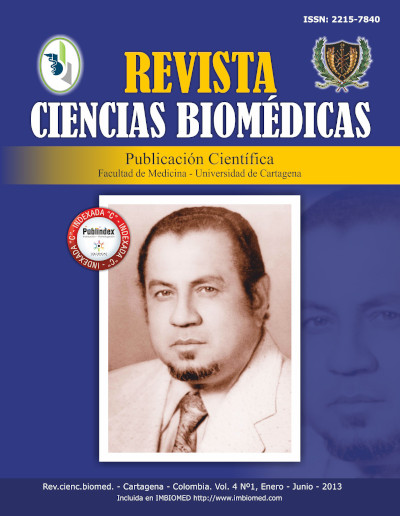Actividad antiinflamatoria y antioxidante de Merremia Umbellata (L.) Hallier f.
Actividad antiinflamatoria y antioxidante de Merremia Umbellata (L.) Hallier f.
Contenido principal del artículo
Resumen
Introducción: Merremia umbellata es ampliamente utilizada en la medicina popular para tratar múltiples enfermedades, incluyendo aquellas que cursan con inflamación.
Objetivos: evaluar el efecto antiinflamatorio y antioxidante del extracto etanólicototal obtenido de las hojas de Merremia umbellata.
Métodos: el material vegetal fue extraído por maceración con etanol. La actividad antiinflamatoria se evaluó utilizando el modelo murino in vivo de edema auricular inducido por 13-acetato de 12-orto-tetradecanoilforbol (TPA), determinando la actividad de la enzima mieloperoxidasa (MPO). Adicionalmente se determinó la inhibición de la producción de óxido nítrico (NO) en macrófagos RAW 264.7 estimulados con lipopolisacarido (LPS). Mientras que la actividad antioxidante se determinó aplicando los métodos espectrofotométricos de captación de los radicales libres DPPH (2,2-difenil-1-picrilhidrazilo), ABTS (sal diamónica del ácido 2,2’azinobis-(3-etilbenzotiazolin 6- sulfónico), NO y H2O2 (peróxido de hidrógeno).
Resultados: el extracto de Merremia umbellata disminuyó el edema y la actividad de la enzima MPO en orejas de ratones inflamadas con TPA, así como la producción de NO en macrófagos activados. Además presentó significativa actividad captadora de los radicales libres DPPH, ABTS y H2O2.
Conclusiones: se demostró actividad antiinflamatoria y antioxidante en el extracto etanólico total de Merremia umbellata. Rev.Cienc.Biomed. 2013;4(1):13-19
Palabras clave:
Descargas
Detalles del artículo
Referencias (VER)
Bayarsaihan D. Epigenetic mechanisms in inflammation. Journal of dental research. 2011;90(1):9-17.
Han J, Shuvaev VV, Muzykantov VR. Targeted interception of signaling reactive oxygen species in the vascular endothelium. Therapeutic Delivery. 2012;3(2):263-276.
Khan AQ, Khan R, Qamar W, Lateef A, Ali F, Tahir M, et al. Caffeic acid attenuates 12-Otetradecanoyl- phorbol-13-acetate (TPA)-induced NF-kappaB and COX-2 expression in mouse skin: abrogation of oxidative stress, inflammatory responses and proinflammatory cytokine production. Food and chemical toxicology : an international journal published for the British Industrial Biological Research Association. 2012; 50(2): 175-183.
Cui XY, Kim JH, Zhao X, Chen BQ, Lee BC, Pyo HB, et al. Antioxidative and acute anti-inflammatory effects of Campsis grandiflora flower. Journal of ethnopharmacology. 2006; 103(2): 223-228.
Poljsak B, Milisav I. The neglected significance of “Antioxidative Stress”. Oxidative Medicine and Cellular Longevity. 2012.
Lalfakzuala R, Lalramnghinglova H, Kayang H. Ethnobotanical usage of plants in western Mi zoram. Indian J Tradit Knowl. 2007;6:486-493.
Entry for Merremia umbellata ssp. umbellata (Linn.) Hall. f. [Family convolvulaceae] [database on the Internet]. Jstor Plant Science. 2005 [cited 27/12/2012].
De Young LM, Kheifets JB, Ballaron SJ, Young JM. Edema and cell infiltration in the phorbol ester-treated mouse ear are temporally separate and can be differentially modulated by pharmacologic agents. Agents and actions. 1989;26(3-4):335-341.
Payá M, Ferrándiz ML, Sanz MJ, Bustos G, Blasco R, Rios JL, et al. Study of the antioedema activity of some seaweed and sponge extracts from the mediterranean coast in mice. Phytotherapy
Research. 1993;7(2):159-162.
Bradley PP, Priebat DA, Christensen RD, Rothstein G. Measurement of cutaneous inflammation: estimation of neutrophil content with an enzyme marker. J of Investigative Dermatology. 1982; 78(3): 206-209.
Shi T, Mazumdar T, DeVecchio J, Duan ZH, Agyeman A, Aziz M, et al. cDNA microarray gene. expression profiling of hedgehog signaling pathway inhibition in human colon cancer cells. PLoS One. 2010;5(10):e13054.
Scudiero DA, Shoemaker RH, Paull KD, Monks A, Tierney S, Nofziger TH, et al. Evaluation of a soluble tetrazolium/formazan assay for cell growth and drug sensitivity in culture using human and other tumor cell lines. Cancer Research. 1988; 48(17): 4827-833.
Ding AH, Nathan CF, Stuehr DJ. Release of reactive nitrogen intermediates and reactive oxygen intermediates from mouse peritoneal macrophages. Comparison of activating cytokines and
evidence for independent production. The Journal of Immunology. 1988;141(7):2407-2412.
Silva BM, Andrade PB, Valentão P, Ferreres F, Seabra RM, Ferreira MA. Quince (Cydonia oblonga Miller) fruit (pulp, peel, and seed) and jam: antioxidant activity. J of Agricultural and Food
Chemistry. 2004; 52(15): 4705-4712.
Re R, Pellegrini N, Proteggente A, Pannala A, Yang M, Rice-Evans C. Antioxidant activity applying an improved ABTS radical cation decolorization assay. Free Radical Biology and Medicine. 1999; 26(9): 1231-1237.
Doerge DR, Divi RL, Churchwell MI. Identification of the colored guaiacol oxidation product
produced by peroxidases. Analytical biochemistry. 1997;250(1):10-17.
Arnstein PM. Evolution of topical NSAIDs in the guidelines for treatment of osteoarthritis in elderly patients. Drugs & aging. 2012;29(7):523-531.
Aagaard L, Hansen EH. Information about ADRs explored by pharmacovigilance approaches: a qualitative review of studies on antibiotics, SSRIs and NSAIDs. BMC clinical pharmacology. 2009; 9(1): 4.
Mulaudzi RB, Ndhlala AR, Kulkarni MG, Finnie JF, Staden JV. Anti-inflammatory and mutagenic evaluation of medicinal plants used by Venda people against venereal and related diseases. J Ethnopharmacol. 2012.
Suhitha S, Gunasekaran K, Velmurugan D. Structure based design of compounds from natural sources for diabetes and inflammation. Bioinformation. 2012;8(23):1125-1131.
Wang Q, Kuang H, Su Y, Sun Y, Feng J, Guo R, et al. Naturally Derived Anti-Inflammatory Compounds from Chinese Medicinal Plants. J Ethnopharmacol. 2012.
Lau D, Baldus S. Myeloperoxidase and its contributory role in inflammatory vascular disease. Pharmacology & therapeutics. 2006;111(1):16-26.
Garrido G, González D, Lemus Y, Delporte C, Delgado R. Protective effects of a standard extract of Mangifera indica L.(VIMANG< sup>®) against mouse ear edemas and its inhibition
of eicosanoid production in J774 murine macrophages. Phytomedicine. 2006; 13(6): 412-418.
Taira J, Nanbu H, Ueda K. Nitric oxide-scavenging compounds in Agrimonia pilosa Ledeb on LPS-induced RAW264.7 macrophages. Food Chemistry. 2009; 115(4): 1221-1227.
Park YM, Won JH, Kim YH, Choi JW, Park HJ, Lee KT. In vivo and in vitro anti-inflammatory and anti-nociceptive effects of the methanol extract of Inonotus obliquus. Jl of ethnopharmacology.
; 101(1-3): 120.
Babu A, Sujatha K, Valli A, Narayana K, Babu B, Satyanarayana P. Anticancer and anti-inflammatory activities of extracts of Merremia emerginata. Biosciences, Biotechnology Research Asia. 2009; 6(2): 835-838.
Arunachalam K, Parimelazhagan T, Manian S. Analgesic and anti-inflammatory effects of Merremia tridentata (L.) Hallier f. International J of Pharmacy and Pharmaceutical Sciences. 2011; 3(1).
Kamalutheen M, Gopalakrishnan S, Ismail TS. Anti-inflammatory and Anti-arthritic Activities of Merremia tridentate (L.) Hall. f. J of Chemistry. 2009; 6(4): 943-948.



 PDF
PDF
 FLIP
FLIP




